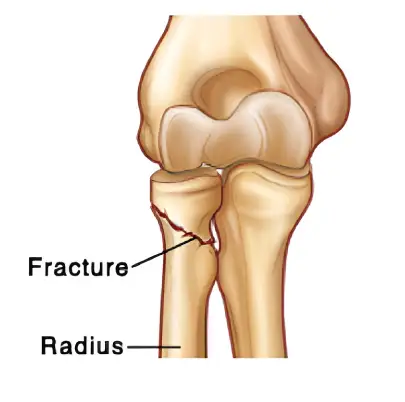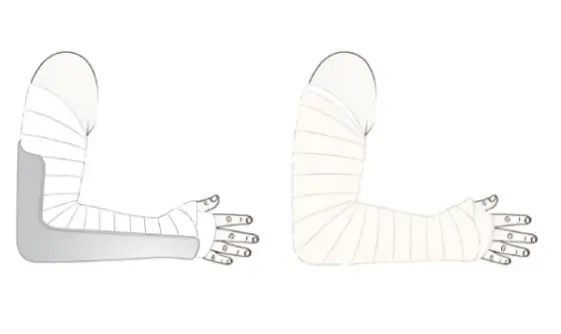The elbow joint is a complex joint of the upper arm which bends and straightens like a hinge. It is also important for rotation of the forearm; that is, the ability to turn your hand in a palm up (like accepting change from a cashier) or palm down (like typing or playing the piano).
Your elbow joint is a joint made up of three bones:

The distal humerus or the lower end of the humerus forms the upper part of the elbow and is the pivot around which the forearm bends and straightens.
The radial head or the upper end of the radius is a knobby end with a flat upper surface which glides up and down in front of the distal humerus when you bend your arm. The radial head also rotates around a groove in the upper end of ulna when you turn your wrist up or down.
The olecranon or the part of the upper part of ulna "hooks" the lower end of the humerus, creating a hinge for elbow movement. The bony "point" of the olecranon can be easily felt beneath the skin.
The elbow is held together by its bony architecture, as well as ligaments, tendons, and muscles. In addition to this, major blood vessel and nerves supplying the forearm and hand cross the elbow joint.
For simplicity of understanding, the elbow joint can either break at the lower end of the humerus (arm bone) or at the upper end of the forearm bones (radius/ulna) either individually or in combination.

A radial head fracture is a break in the upper end of the thumb side forearm bone. Protecting oneself during a fall by taking the impact on your outstretched hand may seem instinctive but the force of the fall could travel up your forearm bones and dislocate your elbow. It also could break the smaller bone (radius) in your forearm. Fractures of the radius often occur in the part of the bone near the elbow, called the radial head.
Radial head fractures are common injuries, occurring in about 20% of all acute elbow injuries. Many elbow dislocations also involve fractures of the radial head. Radial head fractures are more frequent in women than in men, and are more likely to happen in people who are between 30 and 40 years of age.
Radial Head fractures are most often caused by:
The most common symptoms of a radial head fracture include:
Most patients with radial head fractures experience severe difficulty and will consult the emergency department of a hospital. However, some patients may tend to neglect the injury and only visit the hospital/clinic when symptoms do not subside with home remedies. Your doctor will talk with you about your medical history and general health and ask about your symptoms. He or she will then examine your elbow to determine the extent of the injury. During the exam, your doctor will:
Although you may have pain only at the elbow, your doctor may also examine your shoulder, upper arm, forearm, wrist, and hand to ensure that you do not have any other injuries.
Your doctor will order x-rays of your elbow to help diagnose your fracture and also may also order x-rays of your upper arm, forearm, shoulder, wrist, and/or hand to ensure that you do not have any other injuries based on his/her clinical judgement

In the emergency room, your doctor will apply a splint (like a cast) to your elbow and give you a sling to help keep your elbow in position. This prevents any further movements of the broken fragments and thereby limits the chances of nerve injury and also help control any increase in the swelling. Immediate treatment may also include medications to relieve pain. Whether or not your fracture requires surgery will then be determined. Some distal humerus fractures can be treated without an operation, but this is rare.
Your surgeon will distinguish the radial head fractures according to the degree of displacement (how far out of normal position the radial head is, in relation to the remaining intact radial bone). Treatment is determined by the type of fracture.
Type I Fractures
Type I fractures are generally small, like cracks, and the bone pieces remain fitted together
Type II Fractures

Type II fractures are slightly displaced and involve a larger piece of bone.
Type III Fractures
Type III fractures have multiple broken pieces of bone which cannot be put back together for healing.
Even the simplest of fractures may result in some loss of movement in the elbow. Regardless of the type of fracture or the treatment used, exercises to restore movement and strength will be needed before resuming full activities.
It is common to experience pain due to the injury. This can be controlled with medications. In severe cases, your doctor may suggest giving a nerve block by referring to a anaesthetist colleague. Most fractures hurt moderately for a few days to a couple of weeks after the injury. Many patients find that using ice after the slab/stitch removal, elevation (holding their arm up above their heart), and simple, nonprescription medications for pain relief are all that are needed to relieve pain. If your pain is severe, your doctor may suggest a prescription-strength medication, such as an opioid, for a few days. It is important to use opioids only as directed by your doctor. As soon as your pain begins to improve, stop taking opioids.
Whether your treatment is surgical or nonsurgical, recovery from a radial head fracture requires work. During rehabilitation, your doctor or a physical therapist will provide you with exercises to help:
Because nonsurgical treatment can sometimes require long periods of splinting or casting, your elbow may become very stiff. For this reason, you may need a longer period of physical therapy if you are treated conservatively. You will not be allowed to lift, push, or pull anything with your injured arm for a period of time till there is a clinical sign of the fracture uniting.
Depending on the complexity of the fracture and the stability of the repair, your elbow may be splinted or casted for a period of time after surgery. Most patients will begin exercises to improve elbow and forearm motion shortly after surgery, sometimes as early as the next day. It is extremely important to perform the exercises as often as directed. The exercises will only make a difference if they are done regularly
There are risks associated with all surgery. If your doctor recommends surgery, he or she thinks that the possible benefits outweigh the risks. However, there is rare risk of complications with elbow fracture surgery